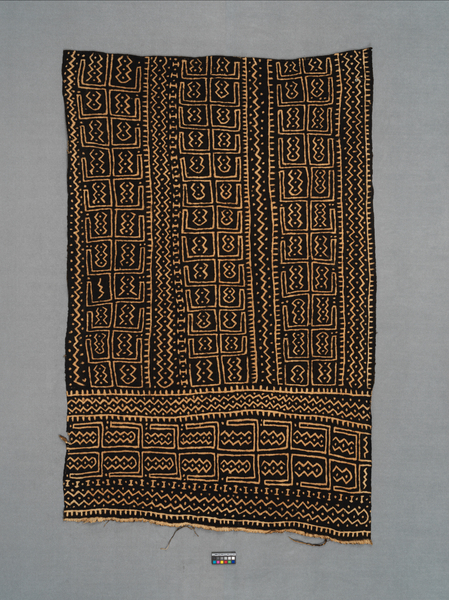Mud Cloth Item Number: 3382/3 from the MOA: University of British Columbia

Description
Mud cloth composed of seven long pieces of hand woven textile, stitched together along the long edges, and dyed black with light brown designs. The cloth is rectangular, with short fringe along one short edge. The overall design is composed of zigzags, lines, repeating T-shapes, and dots.
History Of Use
Prior to Mali's independence from France in 1960, bògòlanfini or bogolan were usually worn by hunters, pregnant women, and anyone in danger of losing blood. Since then, mud cloth has started to be exported and is worn as a symbol of pride.
Cultural Context
Bògòlanfini or bogolan ("mud cloth") has an important place in traditional culture and has more recently become a symbol of Malian cultural identity.
Specific Techniques
The traditionally handmade cotton cloth is soaked in a dye bath made from mashed and boiled leaves of the n’galma tree. Designs are then painted using river mud fermented for over a year, and remain on the dyed cloth following the chemical reaction between tannic acid and iron oxide.
Item History
- Made in Mali
- Owned by John Jeremy Caddy before August 19, 2019
- Received from Nordelph Holdings Ltd. (Donor) on August 19, 2019
What
- Name
- Mud Cloth
- Identification Number
- 3382/3
- Type of Item
- cloth
- Material
- cotton fibre, dye and mud dye
- Overall
- height 169.0 cm, width 107.0 cm
Who
- Culture
- Bamana
- Previous Owner
- John Jeremy Caddy
- Received from
- Nordelph Holdings Ltd. (Donor)
Where
- Holding Institution
- MOA: University of British Columbia
- Made in
- Mali
When
- Ownership Date
- before August 19, 2019
- Acquisition Date
- on August 19, 2019
Other
- Item Classes
- textiles
- Condition
- fair
- Accession Number
- 3382/0003